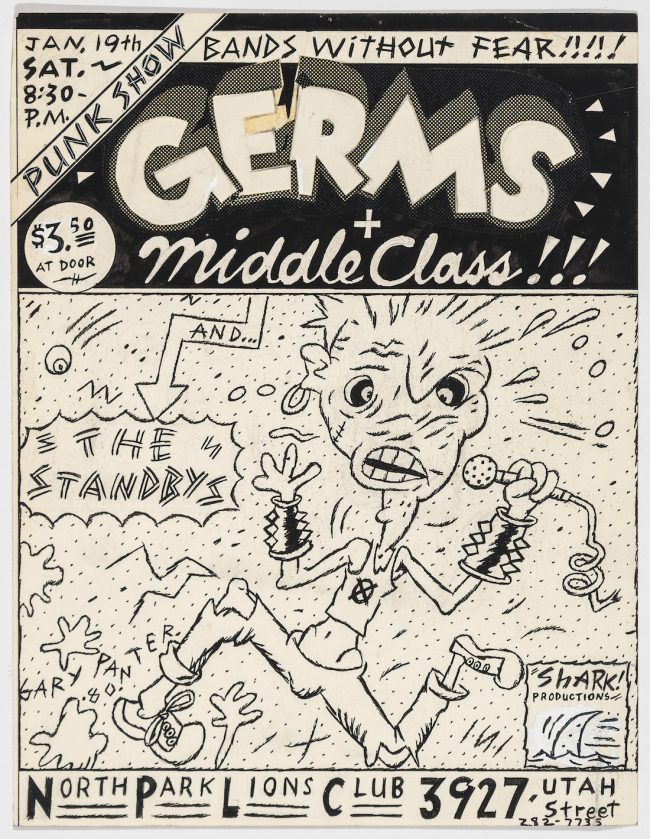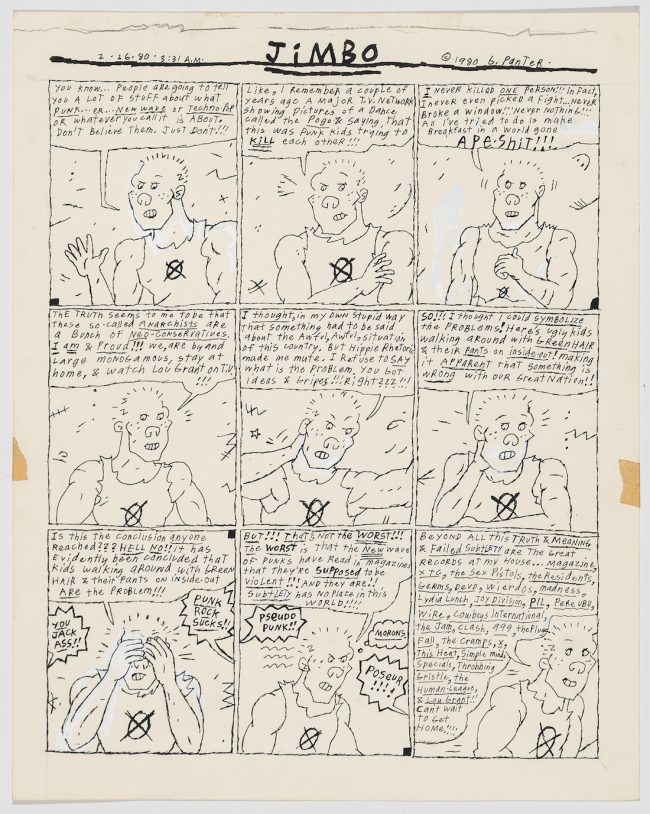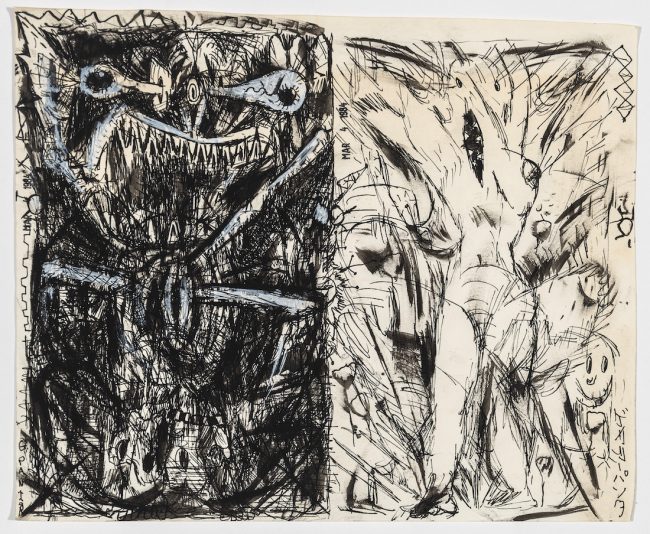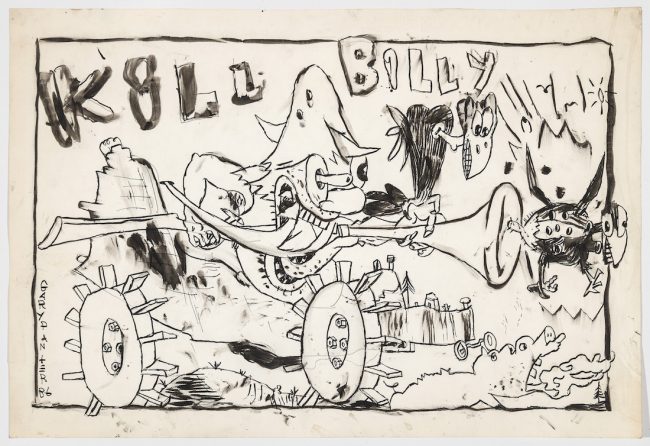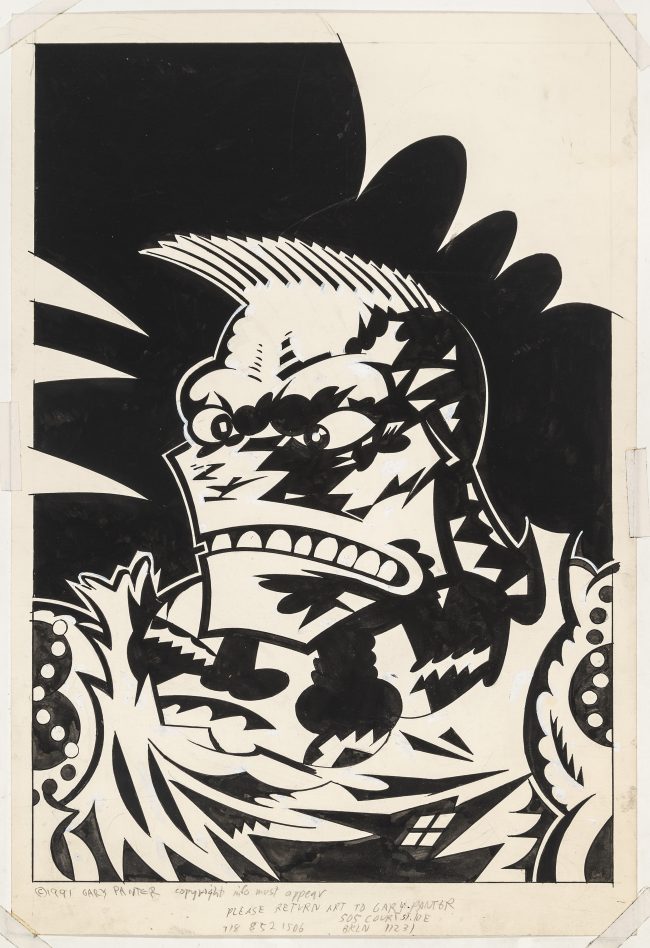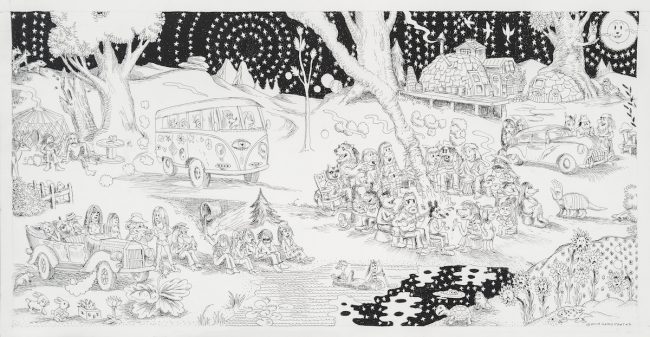Most discussions about Gary Panter’s drawing style reference his ratty line, that rough-hewn descriptor of punk primitiveness that is nearly inseparable from his so-called punk everyman, Jimbo. But Gary has been making marks on paper for at least half a century, and over that time his line has taken many forms. This fall, Dan Nadel and I chose twenty-nine drawings from Gary’s archive for a survey exhibition at Fredericks & Freiser (the show was on view from November 14, 2019, through January 11, 2020). The drawings were made between 1973, during Gary’s art-school days at East Texas State University, in Commerce, and 2019, while at work in his Brooklyn studio; we arranged the work chronologically. Our aim was to undo any fixed notions concerning what kind of artist Gary is and to demonstrate his remarkable range. Even if you are familiar with the variety of his work, it is nonetheless surprising to take in the versatility of his draftsmanship and the range of his formal thinking in a single sweep.
We asked Gary to annotate each drawing in the show with a few sentences in order to give a sense of how the work came into being. His notes reveal an unflaggingly curious mind, exploring every avenue of visual culture—from Big Daddy Roth to Oyvind Fahlstrom to Picasso, and incorporating futurism, pop culture, politics, and personal history. The Gary Panter making conceptual explorations into ecstatic hippie culture today is no less eager and inquisitive than the Gary exhorting his cohorts to infiltrate the mainstream with subversive art in the mid-1970s. Below are these captions, alongside the drawings they illuminate. - Nicole Rudick
All images courtesy of the Artist and Fredericks & Freiser, NY. Photos courtesy of Cary Whittier.
Text by Gary Panter.
Lady with Painted Face, 1973
In glitter rock days, I was living in Arlington, Texas, listening to T. Rex and drawing under headphones, and one night this strange lady emerged.
Rozz Tox and Bin Am Jam, both 1973
This was another of the science-fiction comics that came before Jimbo and the Dal Tokyo world that congealed a year or two later. These comics were like broadsides and gave information in elliptical, rather than rectangular, panels.
When I began to make comics, I didn't have full story ideas, only fragments. An early idea was a religion that worshipped car wrecks. I hadn’t read Crash by J.G. Ballard at that point, but I had read A Clockwork Orange and been affected by its violence and the style of science fiction.
Elvis Zombie, 1979
I was living in LA when Elvis died, and I always thought that he had an alien bearing and would have been good in monster movies, so I wrote and drew a book on that topic. He was a powerful psychic force, a sexualized psychic force, and a lot of monster movies have that sexual aspect to them. There’s always a monster carrying a woman around.
Germs and Middle Class, 1980
Once upon a time I was married to the manager of the Germs and was sometimes called upon to do flyers. I didn't do a lot of them. This was one of my favorite punk images.
When punk first happened, it was hard to find the records, and there weren’t many. A few years later, there were too many records, and new record shops in L.A. had opened. Vinyl Fetish was one of them. It featured punk, post punk, and experimental music. This is not a literal portrayal of it, but a dream-like version.
Jimbo Editorial, 1980
This is a self-conscious Jimbo-on-a-soapbox comic where I made the mistake of having Jimbo say that maybe punk rockers were conservatives, because at that point punks were trying to be the opposite of hippies, and I was trying to figure out the thrust of the punk-rock movement in L.A. This comic is really early, and I wasn’t politically well-educated. I was trying to speak reason, because some kids thought it was the end of friendship! I think punks were another version of hippies.
Jimbo: Aftermath, 1981
RAW was a large-format magazine that was the first forum in the US for comics that aspired to art. There, I was able to do longer stories and in any media I wished. I did a story about the aftermath of a small atomic explosion as a meditation on the bombing of Hiroshima and Nagasaki.
Jimbo is “Running Sore” (page 2), 1981
This is a page from a comic that treats the issue of my Choctaw blood. I am white but am a member of the Choctaw nation, as my grandmother was Choctaw. When I was a kid there were old people who still spoke Choctaw. My grandmother went to Indian school, where they “got the Indian out of you.” The US government has always behaved badly relative to natives in treaties, transportation, and cheating percentages of blood.
Henry Webb’s Hollywood, 1983
I did this map for a free weekly paper in LA. I didn’t have a car for many years in L.A., so I walked around. This was my crawling man’s guide to Hollywood, according to Henry Webb, my evil character.
Spiked Hair, 1983
There were kids that had hair like this and even still—spiked hair with a lot of syrup, hairspray, and gel to get the extreme effect. Jimbo, my main punk character, never had hair like this in a story, only in this drawing. Jimbo was a short-spiked-haired kid, an observer rather than instigator, which made him good later as a stand in for Dante. I was an observer in punk rock. I never jumped in the mosh pit. I stood in the back, or on the sides, or even backstage, observing.
Screamer, 1982
The screaming face was a logo I did for the band the Screamers. I combined their faces somewhat and featured their electric hairstyle. Also, a few years before, I had made notes for a story about a King Kong–like Mexican wrestler who is struck by lightning in a storm, and that was also on my mind. I did various versions of the image for the band and for t-shirt designs and a few painted variations.
This is a drawing that has two sides, as if drawn in an open sketchbook, and the halves are meant to contrast and echo each other.
Killbilly, 1986
I started this as a collaboration with Edwin Pouncey, my English friend. The idea was to try to come up with another Ed Roth monster kit, except weirder. We had the idea of a hillbilly in a car made out of a mountain landscape and running over a pig. It’s nostalgia for being a twelve-year-old.
I could paint pictures from my comic stories, but I don't like the feel of that, so I look to the landscape of media for images that I can transform or rewrite in a way that I can then use as a painting template. This is one of those images becoming a form to paint.
Guy in a Dinosaur Suit, 1983
The first monster movie I saw was The Land Unknown, which features ambitious but very phony volcanic landscapes and guys in monster suits. The unreality of that really stuck with me— theatricality and the possibility of the suspension of disbelief by crude means.
Jimbo’s House Is Gigantic and Condemned (page 8), 1987
When I finally got going, got the ball rolling on RAW, I made this strip as the first story in the second Jimbo collection. I tried to pull out all the stops and do something spectacular. I’d been telling my friends for years I had this place in my mind called Dal Tokyo, and once I started drawing for Slash and stuff, I realized I had never drawn it properly. When I started the Dal Tokyo strip, I was still trying to get out what I was seeing in my head. This was a good example of what a place in Dal Tokyo might look like.
Okupant X, 1991
An early graphic story of mine was published by Diana’s Bimonthly Press poetry journal and featured this character, Okupant X, going to a kabuki-type show that contains Elvis Zombie references. It’s drawn under the influence of Victor Moscoso and Robert Williams, though it doesn’t really look like their work. It’s built out of a lot of dark shapes. This was a redrawing of the character who had run as a cover of RAW magazine and, later, on a large bus-shelter poster.
This is a simple drawing thinking about cultures that have a unified symbol system—Egyptian or Mayan or Aztec.
Psychedelic Screamer, 1995
A decade or more after I designed the Screamer punk-rock image, I decided to remake it in a psychedelic form. This is the resulting explosion, using common tropes of ’60s posters and art.
Mutation Sequence, 1984
As a teen under the influence of Picasso, I began to draw and redraw images, letting the shapes degrade, reform, become angular or softer to see where this might lead. The first page begins a series of improvisations altering the proportions and angles of a figure. The second and third pages continue the distortion of the initial figure, maybe as if the lines are adrift in moving water.
I Drew the Sponge (page 20) from Jimbo in Purgatory, 1999
 Such Pulsing Springs (27) from Jimbo in Purgatory, 1999
Such Pulsing Springs (27) from Jimbo in Purgatory, 1999
The Innocent Root of All Man’s Seed (28) from Jimbo in Purgatory, 2000
 Snowflakes Falling New (29) from Jimbo in Purgatory, 2000
Snowflakes Falling New (29) from Jimbo in Purgatory, 2000
Since I carry with me entanglements of a childhood processed through fundamentalist evangelical Christianity, it was good for me to study Dante, Milton, and Blake to contrast the limited and strict reading of religion I knew in Texas.
Psychedelic Landscape, 1999
I have studied my favorite hippie cartoonists and poster artists for many years and try to combine and advance or think about their portrayals of psychedelic mental landscapes.
Jimi, 1999
This is when I was starting to build my small light show on Roebling Street in Brooklyn. I was making fliers and posters that I put up at the local record shop. The little light show I did was my first formalized attempt to make some small magic that would restart the ‘60s. There’s always a lot of Karl Wirsum hanging around in this kind of work—when it has weird shapes and a face in the middle.
Smulkin, 1999
This comes from two images that I had for a long time. One’s a postcard of an amusement park, and the other is a little collectible bottle top of Ultraman Monsters. I put them together and always intended to paint this. I didn’t make up the sources, but it’s really very much like the place I’m trying to suggest through the drawing. Dal Tokyo is the imaginary setting of many of my comics—a science-fiction cartoon world. The place is an accumulation of things that interest me and the resulting terrain.
Hovering Dr. Nightmare Telephone, 2000
“The rotor flew across the room, showering with unglued metal shards on everyone below.” I made this as a flyer for a small light-show project I built in my Williamsburg studio around 2000. It is trying to participate in and evolve the idea of a ’60s psychedelic poster. Hippie black-light posters were hard to read, and you felt like you were in a special club if you could decipher them. Part of what I was doing was trying to obscure the information, not provide it. I’d hang these at the local record shop and when people asked about them, they’d get verbal information about the light show.
Born Wild, 2012
I was trying to see if I could put together two different things—a line drawing and these big black shapes, which are almost like sounds. I used black ink, then a waxy white pencil, and then white acrylic, and then black ink again. The black ink was on something bigger, like a speedball nib, and then another part is drawn probably with a small steel nib.
Fog Pad, 2019
I have a long-term project on the topic of early hippie dreams that takes many forms. This drawing is the second in a series of scenes of hippie animals gathering in the country and recalls the underground comics of the ’60s and ’70s.







